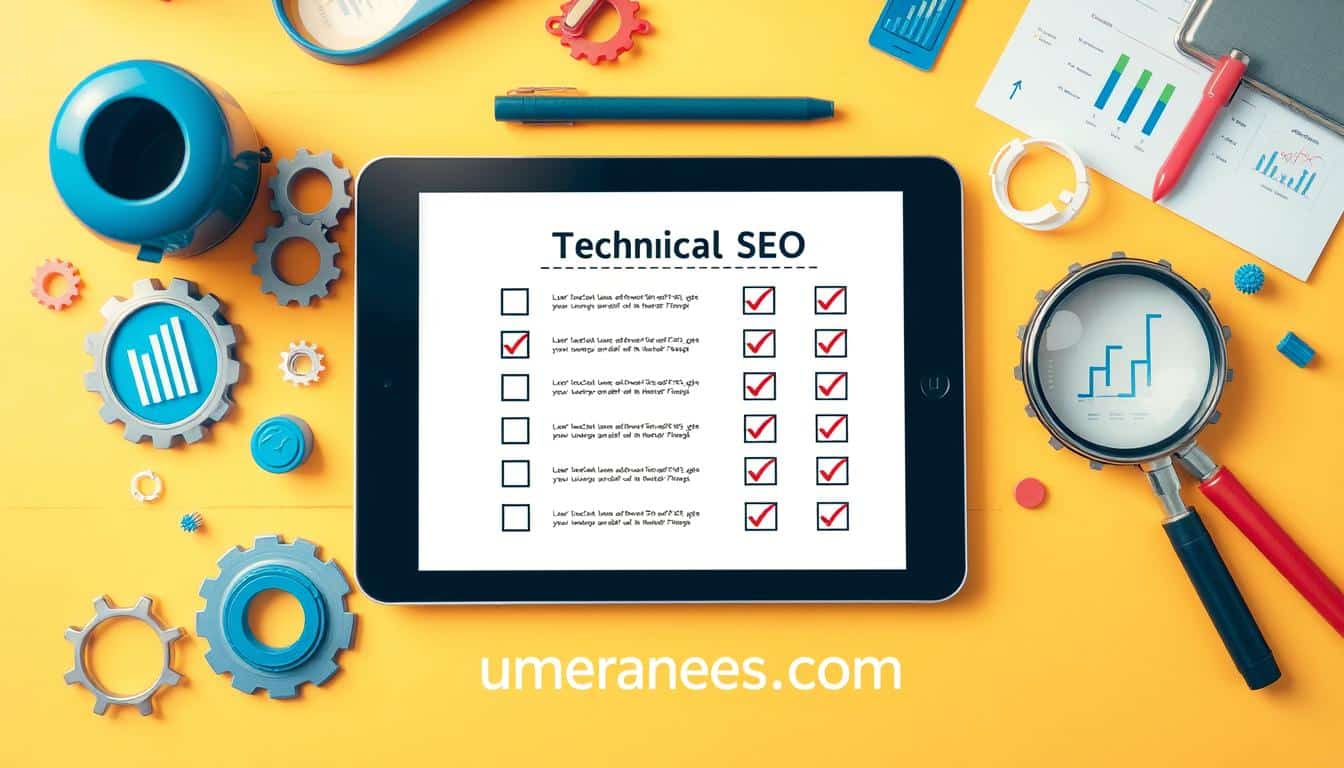In the ever-evolving digital landscape, e-commerce businesses face a crucial challenge: standing out among the sea of online stores. One powerful tool that can propel your e-commerce website to new heights is Search Engine Optimization (SEO). But what if I told you that effective SEO could be the difference between thriving sales and a stagnant online presence?
In this comprehensive article, we’ll explore the ins and outs of SEO for e-commerce websites, providing you with actionable strategies to boost your online sales. From in-depth keyword research to optimizing your product pages, we’ll uncover the secrets to driving more traffic, converting more leads, and ultimately, increasing your bottom line.
Key Takeaways
- Understand the importance of SEO for e-commerce websites and its impact on sales
- Conduct effective keyword research to target the right audience
- Optimize product pages to enhance visibility and conversions
- Implement on-page SEO best practices to improve search engine rankings
- Leverage content marketing and social proof to build trust and credibility
Understanding the Importance of SEO for E-commerce
As an e-commerce business owner, it’s crucial to understand the power of search engine optimization (SEO) and its role in driving success for your online store. SEO for e-commerce involves optimizing your website and its content to improve visibility in search engine results, ultimately driving more organic traffic and increasing sales.
What is E-commerce SEO?
E-commerce SEO is the process of enhancing your online store’s presence on search engine result pages (SERPs) to attract potential customers. This includes optimizing product pages, site architecture, and content to ensure your e-commerce website ranks higher for relevant search queries. By improving your e-commerce optimization, you can increase your online store visibility and capture a larger share of search engine rankings.
Why SEO Matters for Online Stores
- Increased organic traffic: Effective e-commerce SEO helps your products and services appear more prominently in search results, leading to more visitors to your website.
- Higher conversion rates: Well-optimized product pages and a user-friendly website experience can translate into more sales and a better return on investment (ROI).
- Competitive advantage: By outranking your competitors in search results, you can attract a larger share of the target market and establish your online presence as a trusted authority.
- Long-term sustainability: Investing in SEO for your e-commerce business can provide lasting benefits, as your website continues to rank highly and drive consistent traffic over time.
Understanding the importance of e-commerce SEO is the first step towards optimizing your online store for increased visibility and search engine rankings, ultimately leading to a more successful and thriving e-commerce business.
Conducting Effective Keyword Research
Successful e-commerce SEO starts with thorough keyword research. By identifying the right keywords and phrases, online retailers can attract the right audience and improve their chances of driving sales. In this section, we’ll explore the top keyword research tools and delve into the power of long-tail keywords.
Tools for Keyword Research
When it comes to keyword research tools, there are several options available to e-commerce businesses. Some of the most popular and effective tools include Google Keyword Planner, Ahrefs, SEMrush, and Ubersuggest. These platforms provide valuable insights into search volume, competition, and related keywords, allowing you to make informed decisions about your SEO strategy.
Long-tail Keywords: A Key to Success
While broad, high-volume keywords may seem like the obvious choice, long-tail keywords can be a game-changer for e-commerce SEO. These more specific, less competitive phrases often have a lower search volume, but they tend to attract users who are further along in the buying process. By targeting long-tail keywords, you can capture qualified traffic and improve your conversion rates.
“The key to e-commerce SEO success lies in finding the perfect balance between high-volume and long-tail keywords. It’s a delicate dance, but mastering it can pay dividends in the form of increased sales and higher ROI.”
By leveraging the right keyword research tools and embracing the power of long-tail keywords, e-commerce businesses can lay the foundation for a robust SEO strategy that drives traffic, engagement, and ultimately, sales.
Optimizing Product Pages
As an e-commerce business owner, the optimization of your product pages is crucial for driving sales and improving search engine visibility. By focusing on three key elements – crafting unique product descriptions, utilizing high-quality images, and leveraging customer reviews – you can create a compelling and SEO-friendly online shopping experience.
Crafting Unique Product Descriptions
Product page optimization starts with the creation of unique and compelling product descriptions. Avoid generic or duplicate content, as this can negatively impact your search engine rankings. Instead, craft product descriptions that highlight the key features, benefits, and unique selling points of your offerings. Use the target keywords product page optimization and unique descriptions naturally throughout the text to boost your SEO.
Utilizing High-Quality Images
Visuals play a crucial role in online shopping, and high-quality product images can make a significant difference in customer engagement and conversion rates. Ensure that your product image optimization is on point by using clear, well-lit, and detailed images that showcase your products from multiple angles. Optimize the images’ file size and alt text to improve their visibility in search results.
The Role of Customer Reviews
Customer reviews are a powerful tool for building trust and credibility on your e-commerce product pages. Encourage your customers to leave reviews, as these can provide valuable social proof and improve your search engine rankings. Respond to both positive and negative reviews in a professional and helpful manner to demonstrate your commitment to customer satisfaction.
“Optimizing your product pages is a surefire way to increase your e-commerce business’s visibility and sales. By focusing on unique content, high-quality visuals, and customer reviews, you can create a winning formula for success.”

Enhancing On-page SEO
As an e-commerce business owner, optimizing your website’s on-page SEO is crucial for improving search engine rankings and driving more traffic to your online store. Two key areas to focus on are title tags and meta descriptions, as well as header tags and their importance.
Title Tags and Meta Descriptions
Your page’s title tag and meta description play a vital role in how your content is displayed in search engine results. Crafting compelling, keyword-rich title tags and meta descriptions can significantly enhance the clickability of your product pages and blog posts. By strategically incorporating relevant on-site optimization keywords, you can improve the visibility of your e-commerce website and entice more potential customers to visit your site.
Header Tags and Their Importance
The header structure of your web pages is another crucial aspect of on-page SEO. Using the proper header structure, with H1, H2, and H3 tags, helps search engines better understand the hierarchy and organization of your content. This, in turn, can positively impact your rankings and make it easier for users to navigate and engage with your e-commerce website.
By focusing on these on-page SEO elements, you can enhance the overall discoverability and appeal of your e-commerce website, driving more qualified traffic and ultimately boosting your sales and revenue.
Building a User-Friendly Site Architecture
In the world of e-commerce, a well-structured website is crucial for both user experience and search engine optimization (SEO). By focusing on site structure, user experience, and navigation optimization, online retailers can enhance their visibility, accessibility, and ultimately, their sales.
Importance of Navigation
Intuitive navigation is the backbone of a successful e-commerce website. Customers should be able to easily find and access the products they’re looking for, without getting lost in a maze of categories and subcategories. Optimizing your navigation menu, leveraging breadcrumbs, and implementing clear calls-to-action can significantly improve the user’s journey through your online store.
Creating a Sitemap
- A sitemap is a roadmap that outlines the structure and hierarchy of your e-commerce website, helping both users and search engines understand the content and organization of your site.
- By creating a comprehensive sitemap, you can ensure that all your product pages, category pages, and other important content are easily accessible and indexed by search engines.
- Regular updates to your sitemap can help you stay ahead of the curve, reflecting any changes or additions to your online store.
| Feature | Benefit |
|---|---|
| Intuitive Navigation | Improves user experience and reduces bounce rates |
| Comprehensive Sitemap | Enhances search engine visibility and indexing |
| Regular Sitemap Updates | Keeps your online store current and adaptable |
By prioritizing site structure, user experience, and navigation, e-commerce businesses can create an engaging and efficient online presence that resonates with both customers and search engines.
Harnessing the Power of Mobile Optimization
In today’s digital landscape, the rise of mobile shopping has become undeniable. Consumers are increasingly turning to their smartphones and tablets to research, browse, and make purchases online. As a result, mobile optimization has become a critical component of any successful e-commerce strategy.
The Shift Towards Mobile Shopping
According to industry data, mobile devices now account for over 50% of all e-commerce sales worldwide. This shift in consumer behavior underscores the importance of optimizing your e-commerce website for mobile users. A seamless, user-friendly mobile experience can significantly impact customer retention, conversion rates, and overall revenue generation.
Responsive Design Best Practices
- Ensure your website uses a responsive design that automatically adapts to different screen sizes and device types, providing an optimal viewing and navigation experience.
- Optimize page load speeds by minimizing image and file sizes, leveraging caching, and implementing a mobile-first approach to content delivery.
- Prioritize a clean, intuitive layout with large, easy-to-tap buttons and navigation menus tailored for mobile users.
- Incorporate mobile-first indexing strategies to ensure your website is properly crawled and indexed by search engines, boosting your overall SEO performance.
| Key Mobile Optimization Metrics | Benchmark |
|---|---|
| Mobile Bounce Rate | Less than 50% |
| Mobile Conversion Rate | Greater than 2% |
| Mobile Page Load Time | Less than 3 seconds |
By embracing mobile optimization and responsive design best practices, e-commerce businesses can create a seamless shopping experience that caters to the growing mobile-first consumer mindset, ultimately driving increased sales and revenue.
“The future of e-commerce is mobile. Businesses that fail to prioritize mobile optimization will inevitably fall behind their competitors.”
Leveraging Content Marketing
In the dynamic world of e-commerce, content marketing has emerged as a powerful tool for boosting search engine optimization (SEO) and driving customer engagement. By tapping into the vast potential of content marketing, online retailers can create a strong digital presence, improve their rankings, and ultimately, increase sales.
Blogging for E-commerce Success
Maintaining a well-curated blog is a cornerstone of effective content marketing for e-commerce businesses. Regular blog posts can help you establish your brand as an industry authority, attract targeted traffic, and showcase your products or services in a compelling manner. Crafting informative, SEO-optimized blog content can significantly boost your online visibility and drive more customers to your e-commerce store.
Using Video Content to Boost Engagement
In today’s visually-driven digital landscape, video content has become a powerful tool for capturing the attention of potential customers. By creating engaging, informative videos that showcase your products or provide valuable industry insights, you can significantly enhance user engagement and improve your SEO performance. Leveraging the power of video can help you stand out in a crowded e-commerce marketplace and connect with your audience on a more personal level.
“Content marketing is a strategic marketing approach focused on creating and distributing valuable, relevant, and consistent content to attract and retain a clearly defined audience — and, ultimately, to drive profitable customer action.”
By seamlessly integrating content marketing strategies into your e-commerce SEO efforts, you can create a holistic and effective approach to driving traffic, engagement, and ultimately, sales. Whether it’s through captivating blog posts or visually engaging video content, the power of content marketing can help you elevate your online presence and stay ahead of the competition.
Utilizing Social Proof and Trust Signals
In the competitive world of e-commerce, building trust is crucial for driving sales and increasing customer loyalty. Two powerful tools in your arsenal are social proof and trust signals. By leveraging these elements, you can effectively showcase your brand’s credibility and inspire confidence in potential buyers.
The Importance of Trust Badges
Trust badges, such as secure payment icons, customer satisfaction seals, and security certifications, act as visual cues that reassure customers about the reliability and safety of your online store. Strategically placing these badges on your product pages, checkout process, and other key areas can significantly improve [https://www.umeranees.com/how-to-do-technical-seo-for-ecommerce-websites/] conversion rates by addressing customer concerns and building trust.
Showcasing Testimonials and Reviews
Prominently displaying customer testimonials and reviews on your website is a powerful way to leverage social proof and trust signals. Positive reviews from previous customers can serve as powerful endorsements, inspiring confidence in new visitors and driving them to make a purchase. Make sure to showcase a variety of reviews, highlighting both the pros and cons, to maintain authenticity and build credibility.
“The customer reviews on this site were so helpful in my decision-making process. I felt confident in my purchase and the product exceeded my expectations.” – Jane Doe
By incorporating trust badges and showcasing genuine customer reviews, you can effectively communicate the quality of your products and services, ultimately boosting [https://www.umeranees.com/how-to-do-technical-seo-for-ecommerce-websites/] sales and driving long-term success for your e-commerce business.
Tracking SEO Performance
Monitoring your SEO performance is essential for ongoing optimization and improving your e-commerce business’s search rankings and sales. By analyzing key metrics and utilizing powerful tools, you can make data-driven decisions to enhance your digital marketing strategy.
Key Metrics to Monitor
When it comes to tracking SEO performance, there are several crucial metrics to keep an eye on:
- Organic Traffic – This metric measures the number of visitors coming to your website through search engines, providing insights into the effectiveness of your SEO efforts.
- Conversion Rate – Tracking your conversion rate helps you understand how well your website is converting visitors into customers, a key indicator of SEO analytics and performance tracking.
- Keyword Rankings – Monitoring your website’s rankings for target keywords allows you to assess the impact of your conversion rate optimization strategies.
- Bounce Rate – A high bounce rate may suggest issues with your website’s user experience or relevance to search queries, prompting the need for further optimization.
Tools for Analyzing SEO Success
Fortunately, there are a variety of powerful tools available to help you track and analyze your SEO performance:
- Google Analytics – This free tool provides comprehensive insights into your website’s traffic, user behavior, and conversion metrics.
- Google Search Console – This platform gives you a clear picture of how Google views and indexes your website, including information on keywords, impressions, and clicks.
- Ahrefs – A robust SEO tool that offers in-depth analysis of your website’s backlink profile, keyword performance, and overall search visibility.
By leveraging these tools and regularly monitoring your SEO analytics, performance tracking, and conversion rate optimization, you can make informed decisions to enhance your e-commerce website’s search engine performance and drive more sales.

Staying Up-to-Date with SEO Trends
In the dynamic world of e-commerce, it’s crucial to stay informed about the latest SEO trends and updates. As search engine algorithms continuously evolve, adapting your strategy accordingly can make all the difference in maintaining a strong online presence and driving sales.
Understanding Algorithm Updates
Search engines like Google frequently update their algorithms to provide users with more relevant and useful results. Keeping abreast of these changes is essential, as they can significantly impact your website’s visibility and ranking. By understanding the implications of algorithm updates, you can proactively adjust your SEO tactics to ensure your e-commerce site remains optimized and competitive.
Adapting to Changes in Consumer Behavior
Consumer behavior is also constantly evolving, and it’s vital to stay attuned to these shifts. From the rise of voice search to the growing importance of mobile-friendly experiences, adapting your SEO strategy to meet the changing needs and preferences of your target audience is key to driving sustainable growth for your online business.







